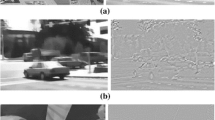Abstract
We present a technique for the computation of 2D component velocity from image sequences. Initially, the image sequence is represented by a family of spatiotemporal velocity-tuned linear filters. Component velocity, computed from spatiotemporal responses of identically tuned filters, is expressed in terms of the local first-order behavior of surfaces of constant phase. Justification for this definition is discussed from the perspectives of both 2D image translation and deviations from translation that are typical in perspective projections of 3D scenes. The resulting technique is predominantly linear, efficient, and suitable for parallel processing. Moreover, it is local in space-time, robust with respect to noise, and permits multiple estimates within a single neighborhood. Promising quantiative results are reported from experiments with realistic image sequences, including cases with sizeable perspective deformation.
Similar content being viewed by others
References
E.H. Adelson and J.R. Bergen, “Spatiotemporal energy models for the perception of motion,” J. Opt. Soc. Amer. A 2: 284–299, 1985.
E.H. Adelson and J.R. Bergen, “The extraction of spatiotemporal energy in human and machine vision,” Proc. IEEE Workshop on Motion, Charleston, pp. 151–156, 1986.
P. Anandan, “A computational framework and an algorithm for the measurement of visual motion,” Intern. J. Comput. Vision 2: 283–310, 1989.
J.L. Barron, “Computing motion and structure from time-varying image velocity information.” Ph.D. thesis, Computer Science Dept., University of Toronto; available as TR: RBCV-TR-88-24), 1988.
R.N. Bracewell, The Fourier Transform and Applications. McGraw-Hill: New York, 1978.
P.J. Burt and E.H. Adelson, “The Laplacian pyramid as a compact image code,” IEEE Trans. Commun. 31: 532–540, 1983.
P.J. Burt, C. Yen, and X. Xu, “Multiresolution flow-through motion analysis,” Proc. IEEE Conf. Comput. Vision Pattern Recog. Washington, pp. 246–252, 1983.
B.F. Buxton and H. Buxton, “Computation of optic flow from the motion of edge features in image sequences,” Image Vision Comput. 2: 59–75, 1984.
J.G. Daugman, “Pattern and motion vision without Laplacian zero crossings,” J. Opt. Soc. Amer. A 5: 1142–1148, 1987.
J.G. Daugman, “Uncertainty relation for resolution in space, spatial frequency, and orientation optimized by two-dimensional visual cortical filters,” J. Opt. Soc. Amer. A 2: 1160–1169, 1985.
D.E. Dudgeon and R.M. Mersereau, Multidimensional Digital Signal Processing. Prentice-Hall: Englewood Cliffs, NJ, 1984.
J.H. Duncan and T.C. Chou, “Temporal edges: The detection of motion and the computation of optical flow,” Proc. 2nd Intern. Conf. Comput. Vision, pp. 374–382, Tampa, 1988.
W. Enkelmann, “Investigations of multigrid algorithms for the estimation of optical flow fields in image sequences,” Proc. IEEE Workshop on Motion, pp. 81–87, Charleston, 1986.
D.J. Fleet, “Measurement of image velocity,” Ph.D. dissertation, Dept. of Computer Science, University of Toronto, 1990.
D.J. Fleet and A.D. Jepson, “A cascaded filter approach to the construction of velocity selective mechanisms,” Technical Report: RBCV-TR-84-6, Dept. Computer Science, Univ. of Toronto, 1984.
D.J. Fleet and A.D. Jepson, “Hierarchical construction of orientation and velocity selective filters,” IEEE Trans. PAMI 11: 315–325, 1989.
D. Gabor, “Theory of communication,” J. IEEE 93: 429–457, 1946.
L.W. Gardenhire, “Selecting sampling rates,” Proc. 19th Instrument Soc. Amer. Conf., July 1964.
F. Glazer, “Hierarchical gradient-based motion detection,” Proc. DARPA Image Understanding Workshop, pp. 733–748, Los Angeles, 1987.
D.J. Heeger, “A model for the extraction of image flow,” J. Opt. Soc. Amer. A 4: 1455–1471, 1987.
D.J. Heeger, “Optical flow using spatiotemporal filters,” Intern. J. Comput. Vision 1: 279–302, 1988.
B.K.P. Horn and B.G. Schunck, “Determining optic flow,” Artificial Intelligence 17: 185–204, 1981.
H.S. Hou and H.C. Andrews, “Cubic splines for image interpolation and digital filtering,” IEEE Trans. Acoustics, Speech, and Signal Process. 26: 508–517, 1978.
M. Jenkin and A.D. Jepson, “The measurement of binocular disparity.” In Z. Pylyshyn (ed.), Computational Processes in Human Vision. Ablex Publishing: Norwood, NJ, 1988.
A.D. Jepson, “Discrete scale-space, multi-scale image representation, and interpolation,” in preparation, 1989.
J.J. Koenderink and A.J. van Doorn, “Local structure of movement parallax of the plane,” J. Opt. Soc. Amer. 66: 717–723, 1976.
J.J. Little, H.H. Bulthoff, and T. Poggio, “Parallel optical flow using local voting,” Proc. 2nd Intern. Conf. Comput. Vision, pp. 454–459, Tampa, 1988.
H.C. Longuet-Higgins and K. Prazdny, “The interpretation of a moving retinal image,” Proc. Roy. Soc. London B 208: 385–397, 1980.
D. Marr and S. Ullman, “Directional selectivity and its use in early visual processing,” Proc. Roy. Soc. LondonB 211: 151–180, 1981.
J. Mayhew and J. Frisby, “Computational studies toward a theory of human stereopsis,” Artificial Intelligence 17: 340–385, 1981.
H.H. Nagel, “Displacement vectors derived from second-order intensity variations in image sequences,” Comput. Vision Graph. Image Process. 21: 85–117, 1983.
H.H. Nagel and W. Enkelmann, “An investigation of smoothness constraints for the estimation of displacement vector fields from image sequences,” IEEE Trans. PAMI 8: 565–593, 1986.
A.N. Netravali and J.O. Limb, “Picture coding: A review,” Proc. IEEE 68: 366–406, 1980.
A.V. Oppenheim and R.W. Shafer, Digital Signal Processing. Prentice-Hall: Englewood Cliffs, NJ, 1975.
T. Sanger, “Stereo disparity computation using Gabor filters,” Biol. Cybern. 59: 405–418, 1988.
J.P.H. van Santen and G. Sperling, “Elaborated Reichardt detectors,” J. Opt. Soc. Amer. A 2: 300–321, 1985.
R.W. Schafer and L.R. Rabiner, “A digital signal approach to interpolation,” Proc. IEEE 61: 692–702, 1973.
D. Slepian, “Some comments on Fourier analysis, uncertainty and modelling,” Siam Review 25: 379–393, 1983.
K.M. Ty and A.N. Venetsanopoulos, “Sampling non-bandlimited signals,” Proc. Telecon '84, Halkidiki, Greece, 1984.
A.B. Watson and A.J. Ahumada, “Model of human visual-motion sensing,” J. Opt. Soc. Amer. A 2: 322–342, 1985.
A.M. Waxman and K. Wohn, “Contour evolution, neighbourhood deformation and global image flow: Planar surfaces in motion,” Intern. J. Robotics Res. 4: 95–108, 1985.
A.M. Waxman, J. Wu, and F. Bergholm, “Convected activation profiles: Receptive fields for real-time measurement of short-range visual motion,” Proc. IEEE Conf. Comput. Vision Pattern Recog. pp. 717–723, Ann Arbor, 1988.
G.B. Whitham, Linear and Nonlinear Waves. Wiley: NY, 1974.
Author information
Authors and Affiliations
Rights and permissions
About this article
Cite this article
Fleet, D.J., Jepson, A.D. Computation of component image velocity from local phase information. Int J Comput Vision 5, 77–104 (1990). https://doi.org/10.1007/BF00056772
Issue Date:
DOI: https://doi.org/10.1007/BF00056772




